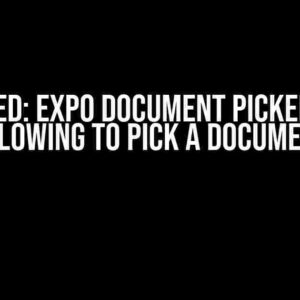The Frustration of Containerization: A Common Conundrum
Have you ever experienced the thrill of setting up a container, only to have it shut down on you without warning? You’re not alone! Many of us have struggled with the infamous “I cannot run my container (maildev image) without instantly exiting on 139” issue. The good news is that you’ve landed on the right page. In this comprehensive guide, we’ll delve into the mysteries of containerization and provide you with clear, step-by-step instructions to overcome this frustrating obstacle.
What’s Behind the Mysterious Error Code 139?
Before we dive into the solution, let’s take a moment to understand what’s causing the problem. Error code 139 typically indicates that the container is terminating due to a segmentation fault or some other unforeseen circumstance. This can occur when the container is attempting to access memory that it’s not authorized to access, resulting in an abrupt shutdown.
Prepare Your Environment: Setting Up Docker and Maildev
Before we can tackle the issue at hand, make sure you have Docker installed and running on your system. If you’re new to Docker, don’t worry – it’s a breeze to set up. Here’s a quick rundown:
docker --versionto check if you have Docker installed. If not, head over to the official Docker website and follow the installation instructions.docker infoto verify that Docker is running properly.- Install the Maildev image using
docker pull maildev/maildev.
Time to Get Your Hands Dirty: Troubleshooting and Fixing the Issue
Now that we have our environment set up, let’s dive into the nitty-gritty of troubleshooting and fixing the issue. Here’s a step-by-step guide to help you overcome the “instant exit on 139” problem:
Step 1: Verify Container Logs
Familiarize yourself with the container logs to identify any potential clues behind the sudden termination. You can do this by running:
docker run --rm -it maildev/maildev /bin/bash -c "tail -f /dev/null"This command will start a new Maildev container and immediately tail the log output. If the container exits with code 139, you should see some error messages indicating the cause of the problem.
Step 2: Check System Resource Availability
Ensure that your system has sufficient resources to run the container. You can check the available resources using:
docker infoTake note of the available CPU, memory, and swap space. If your system is running low on resources, consider upgrading or allocating more resources to the container.
Step 3: Increase Container Resources
Increase the resources allocated to the container by running:
docker run --rm -it --cpus 2 --memory 512M maildev/maildevThis command allocates 2 CPU cores and 512MB of memory to the container. Adjust these values according to your system’s available resources.
Step 4: Disable CPU Pinning
Disable CPU pinning, which can sometimes cause issues with containerization. Run:
docker run --rm -it --cpuset-cpus 0 maildev/maildevThis command disables CPU pinning and allows the container to use all available CPU cores.
Step 5: Upgrade Maildev Image
Ensure you’re running the latest Maildev image. Run:
docker pull maildev/maildev:latestThis command pulls the latest Maildev image from Docker Hub.
Step 6: Verify Container Configuration
Double-check your container configuration to ensure it’s correct. You can do this by running:
docker inspect --format='{{json .Config}}' maildev/maildevThis command displays the container configuration in JSON format.
Additional Troubleshooting Tips and Tricks
Still stuck? Don’t worry – we’ve got some additional tips to help you troubleshoot the issue:
-
Check for conflicts with other containers or processes running on your system.
-
Verify that the Maildev image is compatible with your system architecture (e.g., x86, ARM, etc.).
-
Check the Docker daemon logs for any error messages related to the container.
-
Try running the container with a different user or group ID using the
-uflag.
| Troubleshooting Tip | Description |
|---|---|
| Check for conflicts | Verify that no other containers or processes are conflicting with your Maildev container. |
| Verify image compatibility | Ensure the Maildev image is compatible with your system architecture (e.g., x86, ARM, etc.). |
| Check Docker daemon logs | Verify that the Docker daemon logs don’t contain any error messages related to the container. |
| Run with different user/group ID | Try running the container with a different user or group ID using the -u flag. |
Conclusion
By following the steps outlined in this guide, you should be able to overcome the “instant exit on 139” issue and successfully run your Maildev container. Remember to stay vigilant and troubleshoot any issues that may arise during the process. Happy containerizing!
If you’re still experiencing issues, don’t hesitate to reach out to the Docker community or seek help from online forums. With patience and persistence, you’ll be running your Maildev container in no time!
Final Thoughts and Next Steps
Now that you’ve conquered the “instant exit on 139” issue, it’s time to take your containerization skills to the next level! Consider exploring:
-
Advanced Docker networking and port mapping techniques.
-
Container orchestration tools like Kubernetes or Docker Swarm.
-
Optimizing container performance and resource allocation.
Remember, the world of containerization is vast and exciting. Stay curious, keep learning, and happy coding!
Frequently Asked Question
Get instant answers to your most burning questions about the maildev image container conundrum!
Why does my maildev image container exit instantly with code 139?
Ah-ha! This might be due to a permissions issue! Make sure you’re running the container with the correct user privileges. Try adding the `-u` flag followed by the username or UID to run the container with the required permissions. For example: `docker run -u 1001 maildev`. This should do the trick!
I’ve checked the permissions, but my container still exits with code 139. What’s next?
Okay, let’s dig deeper! Check the Docker logs for any errors or warning messages that might give us a hint about what’s going on. You can do this by running `docker logs -f
I’ve checked the logs, but they’re not giving me any useful information. What should I do now?
Hmm, that’s a bummer! In this case, it might be helpful to try running the container with a different command or entrypoint to see if that makes a difference. For example, you could try running `docker run -it maildev sh` to drop into a shell within the container. This can help you investigate the environment and see if there are any issues with the setup. If you’re still stuck, consider creating a minimal reproduction example to share with the community or seeking help from a Docker expert!
Is there a way to prevent my container from exiting with code 139?
You bet! One way to prevent your container from exiting is to use the `–rm` flag when running the container. This will automatically remove the container when it exits, which can help prevent the container from lingering in an exited state. Additionally, you can use the `-d` flag to run the container in detached mode, which will allow it to continue running in the background even if it encounters an error. For example: `docker run -d –rm maildev`. Give it a try!
I’m still having trouble with my maildev image container. Where can I get more help?
Don’t worry, we’ve got your back! If you’re still having trouble, you can try reaching out to the Docker community on forums like Reddit’s r/docker or Stack Overflow. There are also plenty of online resources and tutorials available that can help you troubleshoot and resolve issues with your container. If all else fails, you can even reach out to the maildev image maintainers directly for support. Good luck, and don’t give up!




![Dead lock with log4cplus: Unraveling the Mystery [Epilog: Was a docker-compose.yml ‘tty: true’ Missing Problem] Dead lock with log4cplus: Unraveling the Mystery [Epilog: Was a docker-compose.yml ‘tty: true’ Missing Problem]](https://ana.hkhazo.biz.id/wp-content/uploads/sites/783/2024/07/dead-lock-with-log4cplus-unraveling-the-mystery-epilog-was-a-docker-compose-yml-tty-true-missing-problem-with-text-300x300.jpg)

